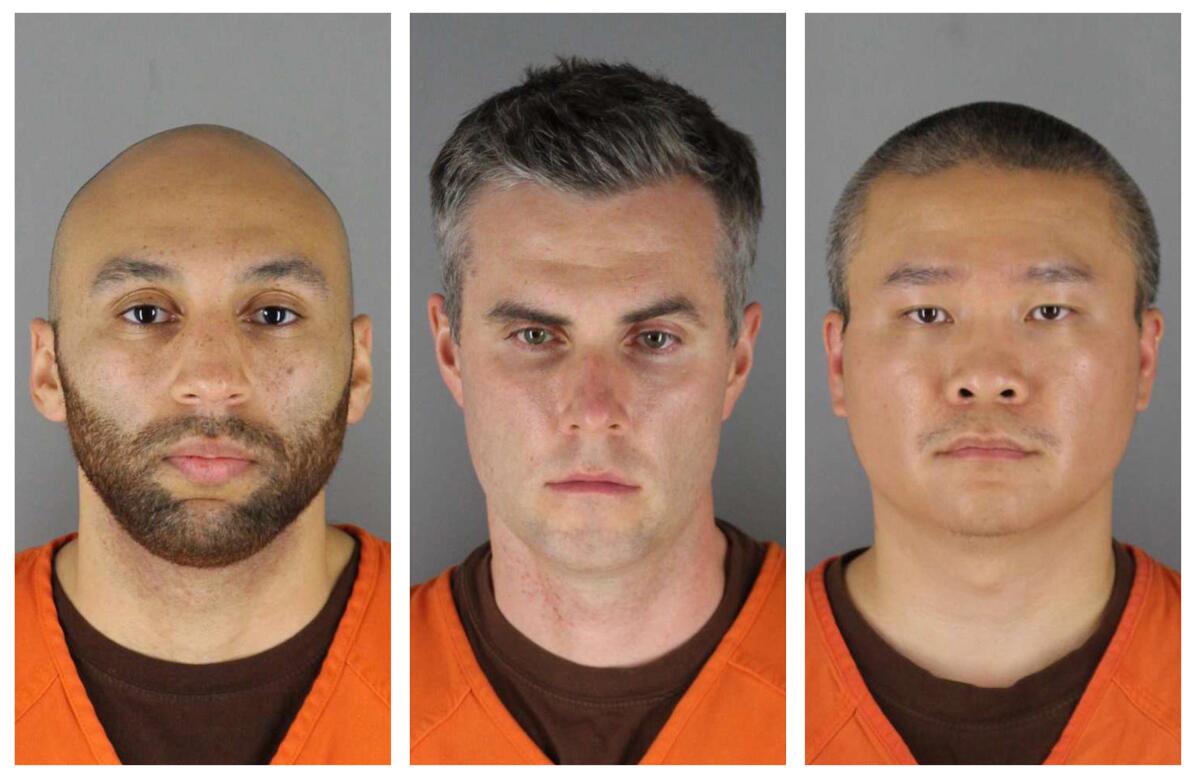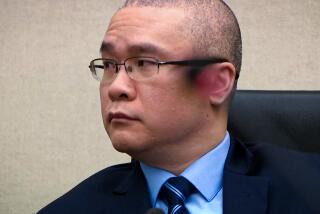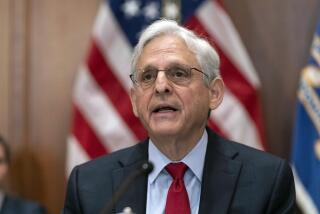Lung expert testifies officers could have saved George Floyd’s life

- Share via
ST. PAUL, Minn. — George Floyd could have been saved if Minneapolis police officers had moved him into a position to breathe more easily, and his chances of survival would have “doubled or tripled” if they had performed CPR as soon as his heart stopped, a lung specialist testified Monday at the trial of three former officers charged with violating Floyd’s civil rights.
Floyd died because his upper airway was compressed by Officer Derek Chauvin’s knee, while his position on hard asphalt with his hands cuffed behind his back — as two other officers helped hold him down — did not allow his lungs to expand, Dr. David Systrom said.
That restricted the flow of oxygen and raised carbon dioxide levels in his body, Systrom, a pulmonologist and critical care physician at Brigham and Women’s Hospital in Boston, said at the federal trial for J. Alexander Kueng, Thomas Lane and Tou Thao.
“Oxygen delivered to the heart and brain is critical to survival,” Systrom said, later calling Floyd’s death “an eminently reversible respiration failure event.”
The trial is in its third week of testimony after it was suspended last week when one defendant tested positive for the coronavirus. The judge has said the trial could take four weeks.
Kueng, Lane and Thao are accused of depriving Floyd, 46, of his rights when they failed to give him medical aid as Chauvin knelt on the Black man’s neck for 9 1/2 minutes. Kueng and Thao are also accused of failing to intervene in the May 2020 killing that triggered protests worldwide and a reexamination of racism and policing.
Kueng knelt on Floyd’s back, Lane held his legs and Thao kept bystanders back.
Systrom, who is also an associate professor at Harvard Medical School, testified that video from Kueng’s body camera shows him holding Floyd’s wrist while pressing it down on Floyd’s back, which would have prevented Floyd from being able to relieve the pressure. In video from Lane’s body camera, it looks as though Kueng’s knee is putting pressure on Floyd’s abdomen, Systrom said. He said “it’s difficult to know” whether Floyd would have died without the pressure Kueng applied.
He said Lane’s restriction of Floyd’s legs also would have prevented Floyd from getting into a position to breathe properly.
Prosecutor Manda Sertich asked what could have been done before Floyd lost consciousness. Systrom responded that it “could have been as simple as removal of pressure on the upper airway by a knee” or letting Floyd sit up.
When asked about Floyd’s chances of survival if officers had immediately begun CPR after his cardiac arrest, Systrom replied: “They would have been doubled or tripled.”
Dr. Andrew Baker, Hennepin County’s chief medical examiner, testified last week that Floyd died after police “subdual, restraint and neck compression” caused his heart and lungs to stop. He said heart disease and drug use were factors but not the “top line” causes.
Systrom said that Floyd did not die of his coronary artery disease or hypertension, and that there was no evidence of a heart attack. Floyd’s medical records showed he had high blood pressure but a mostly normal heart rate and rhythm, he said.
“Would he have died of heart disease on that day if not for the officers’ restraint?” Sertich asked.
“A definitive no,” replied Systrom.
Though Baker did not rule asphyxiation as a cause of Floyd’s death, Systrom agreed under cross-examination by Thao’s attorney, Robert Paule, that his opinion was “entirely different.” He noted that Baker has said he would defer to a pulmonologist and other experts on some issues.
Systrom acknowledged under questioning by Kueng’s attorney, Tom Plunkett, that it’s difficult to tell from videos how much pressure Kueng is applying to Floyd. But he said all the pressure points on Floyd’s body “added up.”
Systrom also said he reviewed multiple videos, Floyd’s medical records, Baker’s grand jury transcripts and testimony from experts at Chauvin’s murder trial last year to assemble a “big picture” view. When Plunkett suggested that Systrom had a lot more information available to him than Kueng did, Systrom pushed back.
“From my opinion, counsel, Mr. Kueng had a front-row seat as to what was going on,” Systrom said.
Lane’s attorney, Earl Gray, got Systrom to acknowledge that Lane asked Kueng to check Floyd’s pulse after not being able to find one in Floyd’s ankle and that Lane got into the ambulance with paramedics to try to help resuscitate Floyd.
Kueng, who is Black, Lane, who is white, and Thao, who is Hmong American, are charged with willfully depriving Floyd of his constitutional rights while acting under government authority. The charges allege that the officers’ actions resulted in Floyd’s death.
Chauvin was convicted of murder and manslaughter in state court last year and pleaded guilty to a federal civil rights charge. He remains in prison.
Lane, Kueng and Thao also face a separate state trial in June on charges alleging that they aided and abetted murder and manslaughter. All three have been free on bail since shortly after they were charged in June 2020.
Webber contributed from Fenton, Mich.
More to Read
Sign up for Essential California
The most important California stories and recommendations in your inbox every morning.
You may occasionally receive promotional content from the Los Angeles Times.










